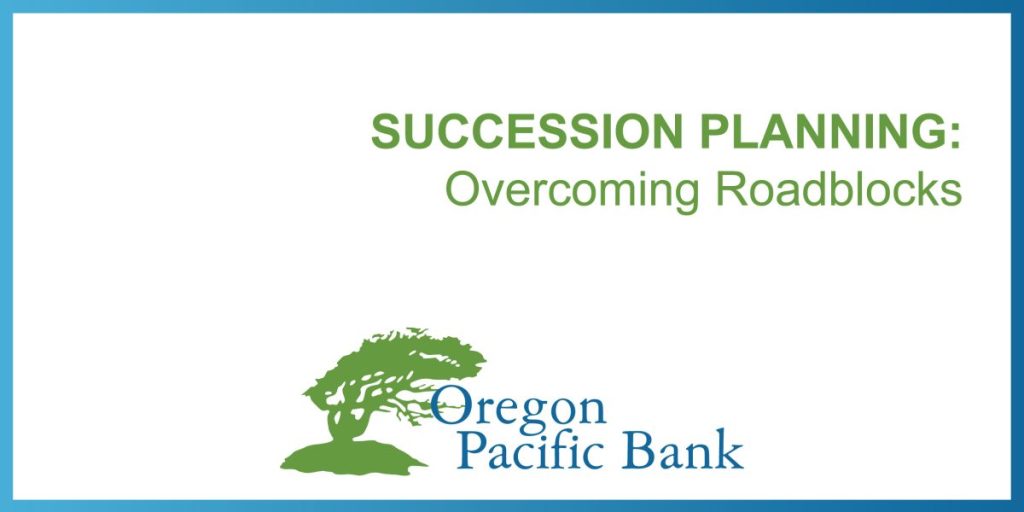If you own a family business and have not yet created an estate plan that includes a very detailed and well-thought-out succession plan for your family business, get started now. Here is why.
Years ago, I received a call from an attorney who asked Oregon Pacific Bank to step in for the eldest son serving as successor trustee of his family’s trust. The trust assets included an incorporated, family-owned custom metal fabrication plant, commercial property, a ranch, tools, equipment, and vehicles, as well as numerous brokerage and bank accounts. The eldest son had worked the plant for years and was identified as the person who would take over and carry on the family enterprise. The trust assets were to be divided equally with his sister, and he was to use his forthcoming share to buy her out of the company.
Five years later, the sister was forced to hire an attorney due to her brother’s total disregard of his fiduciary duties and responsibilities as successor trustee. He had done literally nothing. He did an adequate job running the company but did not have any idea how to administer an estate plan and opted not to hire professionals for guidance. The trust had not been divided upon the death of the first grantor, none of the assets had been retitled to reflect any of the ownership changes, no EIN numbers were obtained, and the situation was exacerbated by incomplete funding of the family trust in the first place. The trust agreement provided no detail or guidance whatsoever regarding the transition of company operations and did not provide adequate liquidity to help effectuate the ambiguous succession plan.
The result was the threat of a lawsuit, long overdue probates for each of the decedent-grantors, the reconstruction of delinquent estate tax returns and final individual returns, five years of corporate income tax returns, as well as five years of fiduciary returns for both the survivors and by-pass trusts. The accounting costs for the time spent reconstructing and filing nineteen tax returns coupled with interest and penalties—and legal and administrative fees—were staggering, and a liquidity crisis ensued. The very existence of the family business and its viability going forward became questionable.
Now consider an alternative.
The owner of a timber company engaged the services of a qualified estate planning attorney. An LLC was formed and transferred into the name of a living trust. The attorney designated Oregon Pacific Bank as successor trustee. The business owner, while living, served as both trustee and beneficiary of the trust. He ran his business normally until he passed away. The trust agreement contained carefully drafted provisions concerning the operations of the business and how ownership decisions were to be made in the event of his disability or death.
Oregon Pacific Bank engaged the services of a timber manager to ensure the seamless transition and uninterrupted revenue of the company. The timberlands were appraised, and the tax work completed with the goal to minimize federal and state tax liability. The trustee held quarterly meetings with the timber manager to review the state of the business, forthcoming expenses, potential investments, risks, and anticipated revenue. The trustee also liaised with the beneficiaries to determine their cash flow needs and exercised discretion to make distributions to the heirs according to the terms of the trust. This is now a five-generation relationship currently sustaining the lifestyle of the grantor’s granddaughter and great-granddaughter.
Keyperson Value vs. Asset Value
If the business revolves around a keyperson, there needs to be a strong business organization built into the estate plan. A company must be created to ensure it survives without its keyperson. Key people may have a poor opinion of or lack confidence in their kids and may need independent council to help the heirs understand the effect of his or her importance to the value of the company. In that case, it may be best for the keyperson or successor trustee to find a buyer for the company or to set up a mechanism to sell the business to a key employee if available. This can be challenging when the value of the company is directly tied to that keyperson who is no longer there and often leads to conflicts and possible legal actions by heirs who have distorted ideas of the value of the family business.
If, however, the value of the company is the value of its underlying assets, such as the timberlands described in the second example, consider who will be the best custodian. Somebody must identify a manager or managers. What if the value of the investment is so high there are only a limited few with the resources to buy it? Who will determine the most effective way to sell the company? How do you go about getting the greatest value for the company?
There are many roadblocks to good succession plans. Unwillingness of a keyperson to give up control and conflict amongst heirs are more common than not. A strong succession plan will clarify expectations and provide detail on how to bring people in and assign responsibilities. It may grant shares in the company to heirs or prospective managers. A succession plan can work well within a trust and with the appointment of a professional successor trustee familiar with the facilitation of business succession plans, including addressing valuation issues, identifying tax and asset title issues, administering buy-sell agreements with family members, or key employees, or selling to third parties. A trust can hold the assets and operate the business. It might hold an LLC or a corporate holding company, or both. It can own life insurance to meet cash flow requirements or to equalize inheritances for those who do not receive the business. A professional trustee would be able to provide oversight of operations, establish discounts, and facilitate the sale of the business either to the younger generation (which works best if they work for and learn the business early on) or by identifying other qualified buyers. Last but certainly not least, a professional trustee has no personal agenda whatsoever, and that goes far towards preventing or diffusing the tension prevalent amongst family members during a difficult transition fraught with emotion.
It is important to understand that a succession plan by way of a last will only takes effect post-death, whereas a living trust enables your successor trustee to take all the steps necessary to maintain operations during the keyperson’s lifetime in the event of financial or physical incapacity.
Corporate trustees or bank trust departments are often saddled with a big bank image of unreachable, inflexible, uncreative, impersonal trust officers operating from out of the area. Oregon Pacific Bank is unique in that it is a community bank offering fiduciary services. The bank and trust department work hard to dispel the negative image of the big bank trust department, and we do that by treating people differently. Our offices are local, and clients can drop by or call anytime. We have direct lines and cell phone numbers we share with our clients. We can be reached after hours and on weekends for urgent matters. We always demonstrate compassion and empathy. We are empowered by senior management and a local board of directors to make decisions and be accountable for them. Our fee structure is based on assets under administration – not hours spent with a client.
What is the next step? Contact us. Make an appointment to become acquainted and discuss the best next steps to help you start your succession planning.

 New Year’s Eve: Closing early at 2 PM | New Year’s Day: Closed all day
New Year’s Eve: Closing early at 2 PM | New Year’s Day: Closed all day







